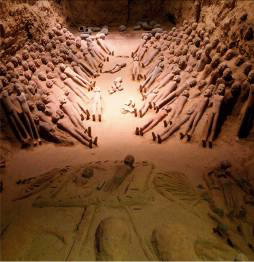FOR IMMEDIATE RELEASE
ACS News Service Weekly PressPac: February 06, 2013
New steps recommended to preserve China's famous Terracotta Warriors and other relics
“Primitive Environment Control for Preservation of Pit Relics in Archeology Museums of China”
Environmental Science & Technology
The preservation of immovable historic relics displayed in large open spaces like China’s world-renowned Museum of Qin Terracotta Warriors and Horses requires air curtains and other modifications to recreate the primitive environment from which archaeologists excavated the relics. That’s the conclusion of a study of environmental control measures for archaeology museums in the People’s Republic of China. Their study appears in ACS’ journal Environmental Science & Technology.
ZhaoLin Gu and colleagues point out that environmental factors have deteriorated many of the more than 1,500 unearthed relics in China’s Museum of Qin Terracotta Warriors and Horses, for instance, and in other museums involving large open spaces. The Qin museum covers an area of more than 17,500 square yards, almost three football fields. More than 5 million people visit the museum every year to see the life-size terracotta figures of warriors and horses uncovered in the mausoleum of Qin Shi Huang, who was born in 259 B.C. and became the first Emperor of all China.
The study recommends new measures to better preserve such artifacts. One, for instance, involves use of an “air curtain” that would blow across the space to separate the figurines in the Qin Museum from the outside environment. The air curtains would keep pollutants and heat away from the inside of the pits. A layer of cool air would also be used in the bottom of the pits to help form a blanket of stagnant air around the relics for protection from the environment.
The authors acknowledge funding from National Science and Technology Ministry of China.
![]()
Contact
Science Inquiries: Michael Woods, Editor, 202-872-6293
General Inquiries: Michael Bernstein, 202-872-6042

preserve such artifacts as China’s famed
Terracotta Warriors and Horses.

